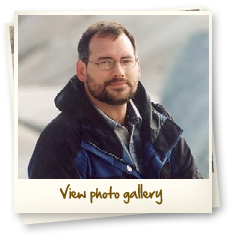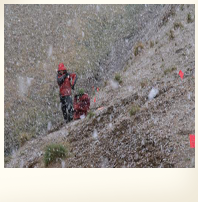

Dr. John Gosse is a Canada Research Chair and Associate Professor with the Department of Earth Sciences at Dalhousie University in Halifax, Nova Scotia. He is the director of the Cosmogenic Nuclide Exposure Dating Facility at Dalhousie, and is an adjunct professor at the University of Kansas (where he taught from 1996-2001 and helps direct a similar facility) and Lehigh University (where he graduated with a Ph.D. in 1994). John was raised in Corner Brook, Newfoundland, completed his B.Sc. (Honours) in Earth Sciences at Memorial University of Newfoundland, and conducted post-doctoral research at Los Alamos National Laboratory. His research involves the application and development of new geological dating techniques that take advantage of the interactions between cosmic rays and exposed rocks on Earth's surface. John, his research group, and his colleagues have helped refine the dating methods and have applied the techniques to date events such as the end of the last ice age in areas throughout Canada, including Peggy's Cove, NS, Gros Morne National Park, NL, and the Arctic islands of Baffin, Ellesmere, and Prescott. He has recently been involved in over 15 international projects to determine, for instance, the timing of volcanic eruptions and the frequency of paleo-earthquakes in California, the incision history of the Grand Canyon, the uplift of the Andes mountains, and fossil evidence of Paleolithic humans in Africa and Israel. He teaches graduate and undergraduate geology courses at Dalhousie to over 400 students per year, has supervised 10 student theses projects, has been awarded 4 prestigious national and international research awards, has published 30 refereed articles, and since his arrival to Dalhousie in 2001 has presented over 40 invited national and international lectures. He is an active member of several international societies, and is associate editor for two journals. John and Annette have three children and a golden retriever who accompany him in the field when possible.
 Q: What is the title of your job and what do you do?
Q: What is the title of your job and what do you do?A: Canada Research Chair in Earth Systems Evolution, and Associate Professor. I spend about 50% of my time on isotope geochemistry research, 30% on teaching, and 20% on administration and financial matters related to the geochronology laboratories.
A: Dalhousie University Department of Earth Sciences, Halifax, Nova Scotia.
A: 8:00 am to 5:00pm, then 9:30 pm to midnight, 6 days per week.
A: Most of my creative writing (journal articles, grant proposals, editing and reviewing of manuscripts, course notes and power point slideshows) is completed in my office in the Oceanography Wing of the Life Sciences Centre. My lab group and I conduct radioactive isotope chemistry experiments in five laboratories and computer modeling in another at Dalhousie. My field areas this year are: Central and High Canadian Arctic (Baffin, Ellesmere, Devon, other islands); remote parts of southern Central Andes, including Patagonia and the seismically active regions around Santiago and Mendoza; western Mozambique; southern California; Atlantic Canada, and hopefully Tibet.
A: My research group and I conduct isotope experiments used to date geological events, natural disasters, human and other fossils, and rates of natural processes responsible for changing Earth's landscape, such as stream and glacier erosion and mountain uplift. There are experiments running 365 days of the year, some by visiting researchers, in our isotope laboratories. For some experiments we use equipment to purify and dissolve specific minerals and chemically extract selected isotopes by ion chromatography, such as 10Be, 26Al, 36Cl, and 14C which are produced in rocks exposed to cosmic rays. To measure those isotopes, we visit and use particle accelerators in the USA and Europe. Hopefully in the near future we will be funded for a Canadian-based accelerator that can achieve the precision we need. Other isotope experiments involve laser heating of individual crystals to extract and count He atoms (alpha particles emitted from the decay of U, Th, and Sm) using the new mass spectrometer in the Department of Earth Sciences at Dalhousie. Much of the geological dating requires high speed computing in order to run Matlab and MathCad models used to calculate the production of the isotopes from cosmic ray bombardment of Earth, or analyse digital elevation models. The equipment in the field is generally simple, including GPS and related survey equipment, field computers, chisels and hammers.
A: Creative. The most successful researchers will devise the most innovative solutions to leading edge questions.
Multi-tasking. We must read the literature, ensure quality assurance in the lab, write grant applications, publish results, participate as reviewers and editors, teach, supervise research, manage contracts and laboratories.
Dedication, passion, and perseverance. Long nights in the lab, weekends writing, weeks in the field in remote regions, failed experiments and rejected manuscripts are bound to occur. Some projects take a decade to complete.
A: $85,000 to $150,000.

A: I like best the self reliance and the choice of working where I want when I want. In a single day I can work on an experiment to improve the chronology method I use, draft figures for a manuscript, reduce accelerator data for contract work for the Canadian Geological Survey, analyse the digital topography of a future field site, advise honours and graduate students on their projects related to climate change and landscape evolution of the Andes, or review a grant proposal submitted by another professor in a foreign country. The pressure to produce is relentless. In general, more hours of efficient and creative work increases the probability of attracting top notch Canadian and international graduate students, publishing more results, attaining more grant funding, and maintaining a high impact to academia and society. Between classes and meetings our time is unstructured, and a professor's success really depends on his or her ability to make the most of that time.
A: Most geology professors in Canada teach for nine months and have the summer months for field work. At many universities, faculty members belong to an association which works like a union to renegotiate a contract each year. The starting salaries are negotiated between the candidate and the university, along with teaching responsibilities, administrative roles, and startup funding that the university may use to help the faculty member construct a laboratory, buy computer equipment, books, office furniture, or whatever the faculty member needs to conduct his or her research. Competent technological support is available in many departments. For instance, in my department, computers, production of rock thin sections for microscope research, general carpentry and maintenance, mass spectrometry, and electron microprobe analysis are supported by trained technicians. Of course the administrative support by office staff is also invaluable, and many of us have grant-paid technical support for our research laboratories.
The amount and destination of travel depends on the research you conduct. For example, geophysicists may not need to conduct much field work at all. Travel is required for data and sample collection. I try not to travel for field work during the teaching semesters, although work in the southern Andes is usually conducted in the Austral summer months. We are expected to disseminate our research results by presenting lectures and posters at other universities or research institutions, and at local, national, and international meetings and workshops, which take us all over the world except Antarctica. Those meetings are fun because of the interaction with people with very different geological training and cultures.
Travel is also needed to visit with colleagues or to use facilities such as high energy accelerator mass spectrometers which are not available in Canada. Because my research interests are diverse and my expertise is useful not only to geologists, I have the opportunity to work with cosmic ray physicists, paleo-geneticists, and archeologists working on the history of migration of Stone Age humans. On a daily basis I interact with undergraduate and graduate students and research colleagues. The students I train at the graduate level have been outstanding, smart, ingenious, inquisitive, careful, dedicated, and respectful. They share my passions for problem solving and learning about Earth's processes. One of the most rewarding aspects of my job is realizing the professional influence I have had on undergraduate or graduate students.
 Q: What are the advancement opportunities for this career?
Q: What are the advancement opportunities for this career? A: The first main hurdle of an assistant professor is to achieve tenure and appointment to associate professor. Some researchers or teachers eventually meet the requirements for full professor. Research and teaching chairs and named professorships sponsored by grant agencies, industry, or the university are also available.
A: Most is lab or office work, but I spend three months of every year in the field. Most field work requires long hours, particularly in the Arctic with 24-hour daylight. Traverses in the Arctic require 20 to 25 km hikes over rough terrain in a wide range of weather conditions with full packs. In Tibet, the elevation of the field work will exceed 4000 m. Some field work is supported by horse and four wheel driving. In the Arctic much of the work could not be completed without helicopter and fixed wing aircraft which in some summers we use daily.
A: I wanted to be a research professor when I was very young, and I had particular interests in chemistry. My parents are both active naturalists, so geochemistry was a logical path. I also like to teach.
A: Here's a recent one. Feeling the few cool huge raindrops at 2 am from a single cumulonimbus cloud while I could still see the Southern Cross from my sleeping bag on the desert sand near an active fault in the southern Andes, after a long hot day of hiking and sampling with one of my colleagues.
A: Experiment. There are many different facets of Earth Sciences.
A: More than any other professional or academic subject, I think geology courses at junior and senior high schools in Canada fail to communicate the reality and breadth of career opportunities in Earth Sciences. The majority of Earth Scientists do not prospect for gold, spend days identifying minerals, dig for dinosaur bones, or drill for oil. A solid background in physics, chemistry, mathematics, and computer sciences has become essential if geology undergraduates intend to compete globally with Earth Science graduates.